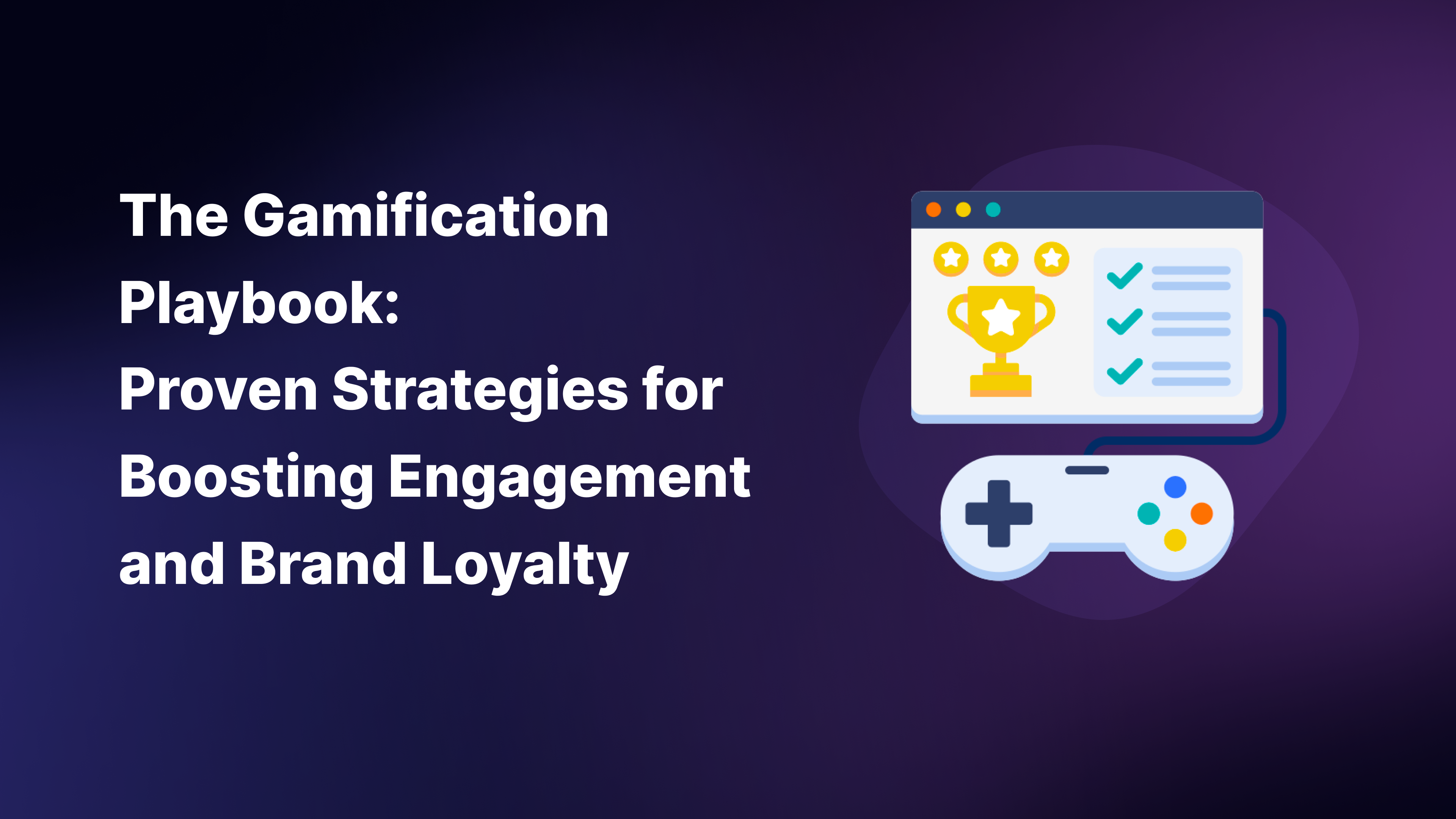What if you could leverage the power of play to captivate your audience and build lasting relationships?
In today's attention-scarce world, brands are constantly battling for consumer engagement and loyalty. Traditional marketing tactics are often met with fatigue and indifference.
That's where gamification steps in, wielding the magic wand of "fun" to transform your marketing tactics. Forget static ads and tedious surveys - gamification injects playful elements like points, badges, and leaderboards, turning interactions into engaging experiences.
Simply put, gamification adds that fun into boring stuff, making it feel more like a game and less like a chore.
This blog post delves into the "Gamification Playbook," offering proven strategies to boost engagement and brand loyalty through the magic of gamification.
Understanding the Power of Play
What is Gamification you might ask. Gamification refers to the strategic use of game elements and design principles in non-game contexts. In simpler words, it's about taking things we don't typically consider "games" and applying elements like points, badges, leaderboards, challenges, and rewards to make them more engaging and motivating.
Humans are inherently drawn to games. They tap into our intrinsic motivations for achievement, mastery, and social connection. Gamification harnesses this power, transforming mundane tasks into engaging experiences that drive desired behaviors. From loyalty programs with reward points to fitness apps with progress bars, gamification is everywhere, and its effectiveness is backed by research.
A study by Bunchball found that gamified experiences increased user engagement by 71% and loyalty by 42%. Let's break it down:
1. Increased User Engagement (71%):
The study suggests that gamification elements can lead to a 71% increase in this metric. This could translate to:
- More frequent app usage or website visit
- Longer time spent interacting with the experience
- Higher completion rates for tasks or activities
- More active participation in discussions or challenges.
2. Enhanced User Loyalty (42%):
The study indicates a 42% increase in this aspect due to gamification. This could manifest as:
- Lower churn rates (users leaving the platform)
- More positive user reviews and recommendations.
- Increased brand advocacy and positive word-of-mouth
- Greater willingness to pay for premium features or services.
However, it's important to note that effective gamification requires careful design and implementation. Simply adding points or badges might not be enough. Understanding user motivations and tailoring gamification elements to their needs is crucial for success.
Building Your Gamification Playbook
Crafting a successful gamification strategy requires careful planning and execution. Here are key steps to consider:
1. Define your goals: What do you want to achieve with gamification? Increase website visits, encourage social media sharing, or boost product purchases? Clearly defined goals guide your entire strategy.
2. Know your audience: Who are you trying to engage? Understanding their demographics, interests, and motivations is crucial for tailoring your gamification elements.
3. Choose the right mechanics: Points, badges, leaderboards, and progress bars are popular choices, but consider more intricate mechanics like quests, challenges, and virtual currencies for deeper engagement.
4. Integrate seamlessly: Gamification should complement, not disrupt, your existing user experience. Ensure smooth integration and clear communication of game rules and objectives.
5. Foster feedback and iteration: Monitor user behavior and gather feedback to adjust your gamification elements for optimal impact. Remember, gamification is an ongoing process, not a one-time solution.
Gamification has found surprising effectiveness in a wide range of areas. It's not just about learning platforms anymore. Businesses use it to motivate employees, fitness apps leverage it to get you moving, and even marketing campaigns incorporate it to build loyalty. Basically, anywhere you need a little nudge towards a desired behavior, gamification might be the secret sauce!
Real-World Examples
Here are some inspiring examples of brands successfully leveraging gamification:
- Duolingo: The language learning app uses points, badges, and leaderboards to keep users motivated and engaged in their language learning journey. More than just points and badges, Duolingo's gamification strategy hinges on understanding intrinsic motivations. The app utilizes streaks to encourage daily practice, creating a sense of loss aversion that drives consistency.
Experience points fuel a progress bar, providing a tangible sense of achievement. Leaderboards foster healthy competition among friends, while customizable avatars and language mastery levels add personalization. This multifaceted approach caters to various motivators, leading to increased user engagement and long-term language learning commitment.
- Starbucks Rewards: Their tiered program, with stars as currency and exclusive rewards, incentivizes repeat purchases and fosters brand loyalty. Forget simple punch cards, Starbucks' tiered program gamifies loyalty. Stars earned with each purchase unlock progressive rewards, from free drinks to birthday treats. Higher tiers offer exclusive benefits like faster star accumulation, free delivery, and early access to new menu items.
This aspirational system motivates repeated purchases and fosters a sense of belonging through exclusive rewards. Even non-coffee drinkers can get in on the game with merchandise and experiences redeemable with stars. This inclusivity widens the program's reach and strengthens emotional connection with the brand.
- Nike Run Club: The app gamifies running with challenges, virtual rewards, and social sharing features, encouraging users to stay active and connected.
Nike FuelBand is a good example. While it is no longer active, the Nike FuelBand campaign stands out for its transformative impact. This wearable tracked daily activity and translated it into "Fuel Points," a universal metric encouraging competition and comparison. Users could challenge friends, share progress on social media, and unlock virtual rewards, creating a fun and engaging fitness experience. This campaign redefined wearable technology and popularized quantified self, establishing Nike as a leader in gamified fitness.
- Revolut, the global neobank known for its mobile app and financial services, has also begun to incorporate gamification elements into its strategy.
Revolut's gamification elements are still evolving, and their full effectiveness in boosting engagement and loyalty remains to be seen. Revolut's use of gamification shows promise. While not as comprehensive as the examples mentioned earlier, their approach suggests they recognize the potential of gamification to increase user engagement and differentiate themselves in a competitive market.
Overly gamified experiences can feel gimmicky and detract from the core user experience. Finding the right balance is crucial.
In a Nutshell, Gamification is a powerful tool for boosting engagement and building brand loyalty. By understanding your audience, defining your goals, and choosing the right mechanics, you can unlock the magic of play and create experiences that resonate with your consumers.
The Dark Side of Play: Risks associated with Gamification
While gamification has become a popular tool for boosting engagement and motivation, its playfulness often hides potential pitfalls. While diving into the gamification playbook, it's crucial to acknowledge the dangers that can arise. Here are some key areas to consider:
- Cheating and Unethical Behavior: The desire to win or progress quickly can incentivise users to cheat or exploit loopholes in the gamified system, undermining its effectiveness and fairness.
- Addiction and Compulsive Behavior: The reward systems and feedback loops in gamification can be addictive, leading to excessive use and neglecting other important activities.
- Undermining Intrinsic Motivation: Over Reliance on external rewards like points and badges can diminish users' internal motivation for the actual task, making them reliant on the gamified system for engagement.
- Ineffectiveness and Disengagement: Poorly designed gamification elements can be boring, frustrating, or irrelevant to the user, leading to disengagement and a negative experience.
To mitigate these dangers, it's crucial to:
- Prioritize transparency and ethical design.
- Focus on intrinsic motivation and meaningful rewards.
- Balance competition and collaboration.
- Collect and use data responsibly.
- Continuously test and iterate the gamified system.
Acknowledging these potential dangers and implementing responsible design practices, gamification can be a powerful tool for engagement and motivation without compromising ethics and user well-being.
Additional Tips to elevate User Experience
- Personalize the experience: Offer customized challenges and rewards based on individual user preferences.
- Tell a story: Craft narratives that integrate your gamification elements into a larger brand story.
- Promote social interaction: Encourage competition and collaboration among users to foster a sense of community.
- Celebrate wins and milestones: Recognize user achievements to keep them motivated and engaged.
- Measure and adapt: Continuously track your gamification efforts and adjust your strategy based on data and user feedback.
Remember, it's not just about points and badges; it's about tapping into the human desire for challenge, progress, and connection. By following these guidelines and staying creative, you can transform your brand into something captivating that your audience will love to interact with. Remember, the ultimate goal is to create a win-win situation where both your brand and your audience benefit from the power of play.
So, grab your gamification playbook, start experimenting, and watch your brand loyalty soar!

